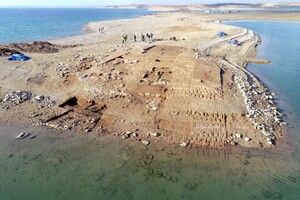Water levels fall due to drought in Iraq.

A team of German and Kurdish archaeologists discovered the ancient city at the age of 3400 years, which was once located on the banks of the Tigris River. The settlement has risen above reservoirs in Mosul due to falling water levels caused by drought in Iraq, according to Phys.org.
Researchers have found a large city with a palace and several large houses. According to them, it may be the ancient Zakiku, which was an important center of the Mittani Empire (1550-1350 BC).
Read also: Archaeologists have found in Peru the mummies of children who were sacrificed
>
Iraq is one of the world's most affected countries by climate change. Yes, the south of the country has been suffering from severe drought for several months. In order to prevent the crops from drying out, a large amount of water is extracted from the Mosul reservoir. As a result, a large ancient city appeared above the water's surface, which was flooded decades ago without any prior archaeological research.
Archaeologists have sought to study and document as much information as possible about this city before it is back under water. A “rescue” excavation team of German and Kurdish archaeologists conducted in January-February 2022. The publication notes that this was a spontaneous decision of several specialists.
Scientists were impressed by the excellent condition of the city walls, some of which reach several meters in height. They have survived, despite the fact that they were made of raw bricks and spent more than 40 years under water. Researchers attribute the good preservation to the fact that the city was destroyed by an earthquake that occurred around 1350 BC. The upper parts of the collapsed walls buried the buildings beneath them.
Scientists also found clay vessels containing an archive of more than 100 cuneiform tablets. They belong to the Middle Assyrian period, shortly after the earthquake in the city. Some clay tablets, which may be letters, are still in their clay envelopes. Researchers hope the discovery will provide important insights into the end of the Mittani city and the beginning of Assyrian rule in the region.
. This will help protect walls and other unburned clay finds, as the city is back under water./strong>. The two decorated panels feature color images, geometric patterns and intricate motifs in a style unique to the British capital.




